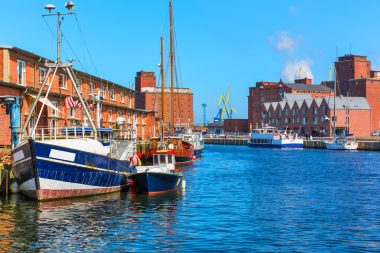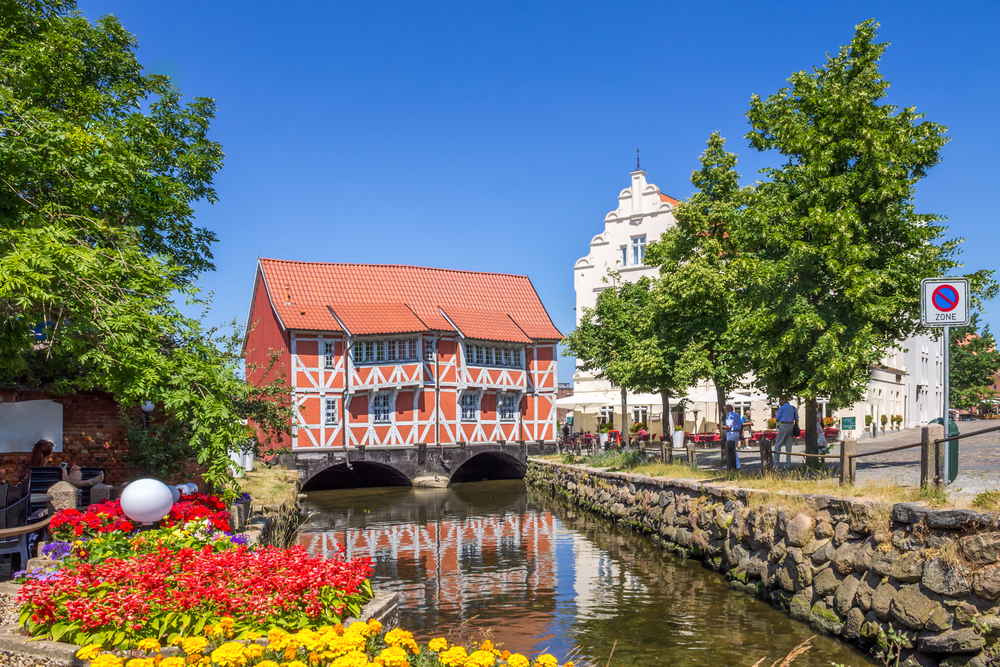The Hanseatic city of Wismar is located in northwestern Mecklenburg and is the sixth largest city in Mecklenburg-Western Pomerania. It can be found on the edge of the Wismar Bay, which is protected by the island of Poel. Together with the old town of Stralsund , Wismar’s old town is a UNESCO World Heritage Site.
Wismar’s history
Wismar belonged to the Hanseatic League early on and experienced a heyday in the Middle Ages. A large number of Gothic monuments bear witness to this glamorous era. From 1648 to 1803, Wismar was part of Sweden. Even today, the annual Sweden Festival commemorates this. Later, the Hanseatic city was transferred to Mecklenburg-Schwerin. Since 2002, Wismar’s old town has been a UNESCO World Heritage Site.
Tourists like to come back to the beautiful Hanseatic city in the northeast again and again. In addition, cruises are also organized from Wismar.
How can Wismar be reached?
Wismar can be easily reached by train. The two lines RE 2 and R 11 run at Wismar station . From Schwerin it is only a 30-minute drive. Other options include bus and car via the A20. Six city bus lines are available within the Hanseatic city.
There is also a ferry connection between Wismar and Kirchdorf, which is located on the island of Poe. Furthermore, harbor tours are carried out.
The sights of Wismar
Most of Wismar’s sights can be admired in the old town. There are several churches there, including the landmark of the Hanseatic city: St. Mary’s Church.
The first church was built in the 13th century, but was badly damaged several times over the centuries. After severe damage in the Second World War, it was blown up in 1960 with the exception of the 80-metre-high tower. The tower can be visited every day at 12 noon. In it, you can learn a lot about the history of Wismar.
Other sacred buildings worth seeing in the Hanseatic city are the imposing Georgian Church, the completion of which took place in 1594, the Holy Spirit Church from the 15th century and the St. Nicholas Church from the 14th century, located in the northern part of the city.
Buildings worth seeing in the Hanseatic city
Wismar has other buildings worth seeing, such as the town hall, which was built in 1319 but collapsed in 1807. In 1819, a new town hall was built on its remains, the style of which was classicist. The Gothic cellar vault is considered particularly interesting, as there are still remains of the old town hall.
Old Swede
The Alter Schwede community centre dates back to the 14th century. One of its unmistakable features is its Gothic brick gable. It initially served as a residential and commercial building. Since 1878 it has been an inn to the present day. In memory of the Swedish era between 1648 and 1803, it bears the name “Old Swede”.
Other buildings worth seeing in Wismar are the baroque armoury with the city library, the Schabbelhaus from 1571 and the building “Zum Weinberg”, which was used as a wine shop from 1648.
Museums in Wismar
Of course, the old Hanseatic city also has some museums to offer. A visit to the Wismar Schabbel Museum of City History is particularly recommended. In two historic town houses, the history of Wismar is the focus of the action. It ranges from the founding of the city in the Middle Ages to the peaceful revolution of 1989 in the GDR. Film and audio stations are also used.
Also worth a visit are the World Heritage House, which houses an exhibition on the old town, the PhanTechnikum technology museum with exhibitions on the history of technology and the Wismar locomotive shed with its railway museum.
Stroll on the market square of Wismar

In the center of the old town is the market square. It has an area of one hectare, making it the most extensive marketplace in the entire Baltic Sea . The town hall is particularly worth seeing. The same applies to the waterworks on the southeast side.
Old Port
A detour should also be made to the Old Port. There is an art gallery in the tree house. Also worth seeing are the components of the old city wall with its two still preserved cannons. From the harbour, harbour tours or trips to Poel are also possible.
Water Gate

In the northwest of the historic city center is the Water Gate, another attraction worth seeing. The harbour gate was built around 1450 in the brick Gothic style and is the last gate of Wismar’s city fortifications that has been preserved.
A visit to the Bürgerpark
About three kilometres from the centre in a westerly direction is the Bürgerpark with its 37-metre-high observation tower, which was built in 2002 for the State Garden Show. The observation deck of the tubular steel tower is located at a height of 28 meters and offers an excellent view of the surroundings.
The Wismar Wildlife Park
Animal lovers get their money’s worth at Wismar Zoo. It is located in a south-westerly direction from the old town embedded in the hilly landscape of Mecklenburg and extends over an area of 13 hectares. In addition to numerous domestic animals, various wild animals can also be admired there, such as the mobile bison.
Swimming in Wendorf
Friends of beach holidays will get their money’s worth in the Wendorf district, 3.5 kilometres from Wismar. There is also a hotel in a park-like environment. The sandy beach slopes slightly, although the waves are limited.
Regular events in Wismar
One of the most famous events held in Wismar every year is the Wismar Herring Days. They usually take place from mid-March to early April.
Culinary specialties
In the Baltic Sea city of Wismar, the focus is of course on fish. There are several restaurants, hotels and pubs that serve fresh fish to their guests. Nightlife enthusiasts will also find some bars and cafés in the Hanseatic city, some of which offer music.


